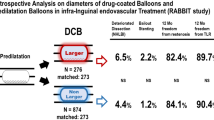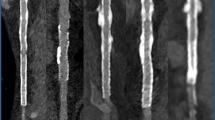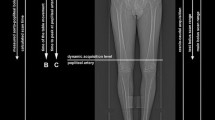Abstract
Purpose
This study aimed to assess the diagnostic accuracy of duplex sonography (DUS) compared with that of computed tomography angiography (CTA) in detecting occlusion and stenosis in peripheral arterial disease (PAD) in candidate patients for endovascular revascularization with intraprocedural digital subtraction angiography (DSA).
Methods
The study involved 94 patients suffering from PAD who were candidates for endovascular procedures requiring DSA. They were all submitted preoperatively to DUS and CTA. Based on image analysis, five segments of the arterial tree were assessed: iliac, common femoral, superficial femoral, popliteal, and infrageniculate.
According to the stenosis or occlusion degree, the arteries were rated as nonstenotic, stenotic, and occluded.
Results
The agreement between DUS and CTA findings using DSA as a reference modality was expressed as a Cohen’s kappa (κ) statistic agreement.
Our results show that DUS has been less accurate than CTA in evaluating iliac arterial diseases (Cohen’s κ agreement of 0.91 and 1.0, respectively) when measured against DSA.
We found good diagnostic concordance between DUS and DSA in detecting hemodynamic stenosis and occlusion of the femoro-popliteal axis (Cohen’s κ agreement between 0.96 and 0.93).
Below the knee, CTA showed even less concordance with DSA (Cohen’s κ 0.75).
Conclusions
Because of its accuracy, high-quality DUS performed by well-trained operators may therefore represent a good alternative to CTA in patients undergoing endovascular revascularization to minimize the use of contrast-enhanced radiological imaging.
Nevertheless, preoperative CTA imaging is required in cases of nondiagnostic DUS or when a more complete overview of the vascular tree is needed for complex invasive interventions.




Similar content being viewed by others
Availability of data and material
The datasets generated during and/or analysed during the current study are available from the corresponding author on reasonable request.
References
Koheler TR (1993) Duplex scanning for the evaluation of the lower limb disease. In: Bernstein EF (ed) Vascular Diagnosis. St Luis Mosby-year book inc.
Duan Y, Wang X, Yang X, Wu D, Cheng Z, Wu L (2013) Diagnostic efficiency of low-dose CT angiography compared with conventional angiography in peripheral arterial occlusions. Am J Roentgenol 201:W906–W914
Jens S, Koelemay MJ, Reekers JA, Bipat S (2013) Diagnostic performance of computed tomography angiography and contrast-enhanced magnetic resonance angiography in patients with critical limb ischaemia and intermittent claudication: systematic review and meta-analysis. Eur Radiol 23(11):3104–3114
Antignani PL, Benedetti-Valentini F, Aluigi L, Baroncelli TA, Camporese G, Failla G, Martinelli O, Palasciano GC, Pulli R, Rispoli P, Amato A, Amitrano M, Dorigo W, Gossetti B, Irace L, Laurito A, Magnoni F, Minucci S, Pedrini L, Righi D, Verlato F (2012) Diagnosis of vascular diseases. Ultrasound investigations—guidelines. Int Angiol 31:1–77
Collins R, Burch J, Cranny G, Aguiar-Ibanez R, Craig D, Wright K, Berry E, Gough M, Kleijnen J, Westwood M (2007) Duplex ultrasonography, magnetic resonance angiography, and computed tomography angiography for diagnosis and assessment of symptomatic, lower limb peripheral arterial disease. BMJ 16:1257–1273
Collins R, Cranny G, Burch J, Aguiar-Ibanez R, Craig D, Wright K et al (2007) A systematic review of duplex scanning ultrasound, magnetic resonance angiography and computed tomography angiography for the diagnosis and assessment of symptomatic, lower limb peripheral arterial disease. Health Technol Assess 11:1–202
Tufano A, Minelli R, Rossi E et al (2020) Inferior epigastric artery pseudoaneurysm secondary to port placement during a robot-assisted laparoscopic radical cystectomy. J Ultrasound. https://doi.org/10.1007/s40477-020-00442-1
Corvino A, Catalano O, de Magistris G, Corviino F, Giurazza F, Raffaella N, Vallone G (2020) Usefulness of doppler techniques in the diagnosis of peripheral iatrogenic pseudoaneurysms secondary to minimally invasive interventional and surgical procedures: imaging findings and diagnostic performance study. J Ultrasound. https://doi.org/10.1007/s40477-020-00475-6
Aboyans V, Ricco JB, Bartelink ML, Björck M, Brodmann M, Cohnert T et al (2018) Editor’s choice—2017 ESC guidelines on the diagnosis and treatment of peripheral arterial diseases, in collaboration with the European Society for Vascular Surgery (ESVS). Eur J Vasc Endovasc Surg 55(3):305–368. https://doi.org/10.1016/j.ejvs.2017.07.018
Favaretto E, Pili C, Amato A, Losinno F, Rossi C, Faccioli L, Palareti G (2007) Analysis of agreement between duplex ultrasound scanning and arteriography in patients with lower limb artery disease. J Cardiovasc Med 8(5):337–341
Bostrom A, Ljungman C, Hellberg A, Logason T, Barlin T, Astholm G, Karacagil S (2002) Duplex scanning as the sole preoperative imaging method for infrainguinal arterial surgery. Eur J Vasc Endovasc Surg 23:140–145
Hingorani A, Ascher E, Marks N (2007) Preprocedural imaging: new options to reduce the need for contrast angiography. Semin Vasc Surg 20:15–28
Katsamouris AN, Giannoukas AD, Tsetis D, Kostas T, Petinarakis I, Gourtsoyiannis N (2001) Can ultrasound replace arteriography in the management of chronic arterial occlusive disease of the lower limb. Eur J Vasc Endovasc Surg 21(2):155–159
Herique Rossi F, Puech-Leao P, Mitsuro IN (2006) Color-flow duplex hemodynamic assessment of runoff in ischemic lower limb revascularization. Vascular 14:149–155
Pemberton M, London NJ (1997) Colour flow duplex imaging of occlusive arterial disease of the lower limb. Br J Surg 84:912–919
Lingush J Jr, Reavis SW, Preissler JS, Hansen KJ (1998) Duplex ultrasound scanning defines operative strategies for patients with limb-threatening ischemia. J Vasc Surg 28:482–491
Aly S, Sommerville K, Adiseshiah M, Raphael M, Coleridge Smith PD, Bishop CC (1998) Comparison of duplex imaging and arteriography in the evaluation of lower limb arteries. Br J Surg 85(8):1099–1102
Osama A, Zaytoun H, Soliman HH (2012) Role of multi-slice CT angiography versus doppler ultrasonography and conventional angiography in assessment of aorto-iliac arterial disease. Egypt J Radiol Nuclear Med 43(4):561–573
Martin ML, Tay KH, Flak B, Fry PD, Doyle DL, Taylor DC, Hsiang YN, Machan LS (2003) Multidetector CT angiography of the aortoiliac system and lower extremities: a prospective comparison with digital subtraction angiography. AJR Am J Roentgenol 180(4):1085–1091
Bui TD, Gelfand D, Whipple S, Wilson SE, Fujitani RM, Conroy R, Pham H, Gordon IL (2005) Comparison of CT and catheter arteriography for evaluation of peripheral arterial disease. Vasc Endovasc Surg 39:481–490
Sarwar A, Rieber J, Mooyaart EA, Seneviratne SK, Houser SL, Bamberg F, Raffel OC, Gupta R, Kalra MK, Pien H, Lee H, Brady TJ, Hoffmann U (2008) Calcified plaque: measurement of area at thin-section flat-panel CT and 64-section multidetector CT and comparison with histopathologic findings. Radiology 249(1):301–306
Edwards JM, Coldwell DM, Goldman ML, Strandnness DE Jr (1991) The role of duplex scanning in the selection of patients for transluminal angioplasty. J Vasc Surg 13:69–74
Brahee DD, Ogedegbe C, Hassler C (2013) Body mass index and abdominal ultrasound image quality: a pilot survey of sonographers. J Diagn Med Sonogr 29(2):66–72
Shaalan WE, French-Sherry E, Castilla M, Lozanski L, Bassiouny HS (2003) Reliability of common femoral artery haemodynamics in assessing the severity of aortoiliac inflow disease. J Vasc Surg 37:960–969
Haimovici H, Shapiro JH, Jacobson HG (1960) Serial femoral arteriography in occlusive disease: clinical-roentgenologic considerations with a new classification of occlusive disease. Am J Roentgenol 83:1042
Ubbink DT, Fidler M, Legemate DA (2001) Interobserver variability in aortoiliac and femoropopliteal duplex scanning. J Vasc Surg 33:540–545
Koelemay MJ, Legemate DA, Van Grup JA, De Vos H, Balm R, Jacobs MJ (2001) Interobserver variation of colour duplex scanning of the popliteal, tibial and pedal arteries. Eur J Endovasc Surg 21:160–164
Larch E, Minar E, Ahmadi R, Schnürer G, Schneider B, Stümpflen A, Ehringer H (1997) Value of duplex sonography for evaluation of tibioperoneal arteries in patients with femoropopliteal occlusions: a prospective comparison with anterograde intraarterial digital subtraction angiography. J Vasc Surg 25:629–636
Kallen AJ, Jhung MA, Cheng S (2008) Gadolinium-containing magnetic resonance imaging contrast and nephrogenic systemic fibrosis: a case-control study. Am J Kidney Dis 51(6):966–975
Koelemay MJ, Legemate DA, De Vos H, Van Grup JA, Balm R, Reekers JA, Jacobs MJ (2001) Duplex scanning allows selective use of arteriography in the management of patients with severe lower leg arterial disease. J Vasc Surg 34:661–667
Wong TH, Tay KH, Sebastian MG, Tan SG (2013) Duplex ultrasonography arteriography as first-line investigation for peripheral vascular disease. Singapore Med J 54:271–274
Funding
The author(s) received no financial support for the research, authorship, and/or publication of this article.
Author information
Authors and Affiliations
Corresponding author
Ethics declarations
Conflict of interest
The authors have not conflicts of interest or competing interests.
Ethical approval
Approval was obtained from our ethics committee. The procedures used in this study adhere to the tenets of the Declaration of Helsinki.
Informed consent
Each patient has signed the informed consent, required by our hospital, for diagnostic tests and for therapeutic procedures.
Additional information
Publisher's Note
Springer Nature remains neutral with regard to jurisdictional claims in published maps and institutional affiliations.
Rights and permissions
About this article
Cite this article
Martinelli, O., Alunno, A., Drudi, F.M. et al. Duplex ultrasound versus CT angiography for the treatment planning of lower-limb arterial disease. J Ultrasound 24, 471–479 (2021). https://doi.org/10.1007/s40477-020-00534-y
Received:
Accepted:
Published:
Issue Date:
DOI: https://doi.org/10.1007/s40477-020-00534-y




